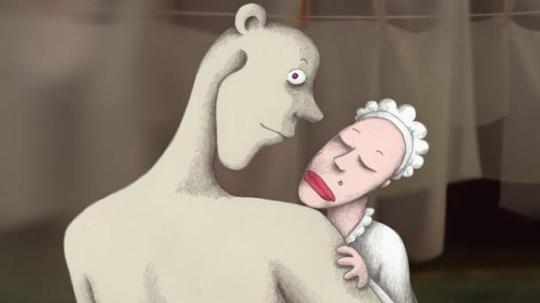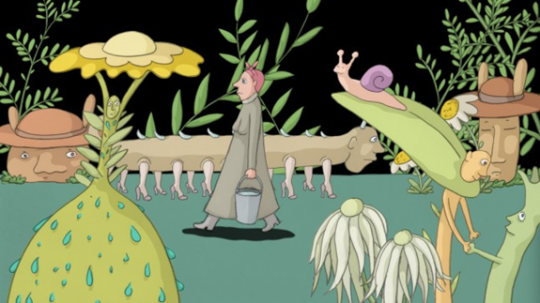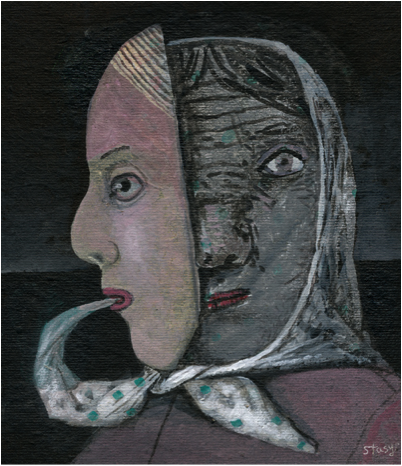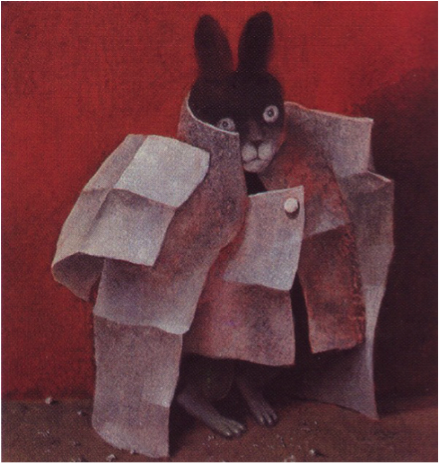
An Interview with Animator Signe Baumane
Signe Baumane is a Latvian animatorliving and working in New York. Her latest film, an animated memoir called Rocks
in My Pockets (2015), is a tragi-comedy about her
family history of depression. Narrated by Baumane herself, the film unfolds as
an essay read aloud in manic, often carnivalesque tones, accompanied by surreal
imagery meant to approximate an invisible landscape of the mind. In one
memorable scene, her mother walks, like a demented Snow White, through the deep
forest of her consciousness, greeting the many little woodland monsters—depression spirits—that accompany her wherever she goes. In these moments,
animation serves not to supplant or overpower Baumane’s spoken narration, but
to reveal the strange beauty and inherent comedy of language often used to
describe mental illness (“I felt haunted by myself”). Though it is her first
feature-length animation, Rocks
in My Pockets is not Signe Baumane’s
first crack at animating the unspeakable. Her web series, The
Teat Beat of Sex (2010) is a series of short
vignettes about the hang-ups and confusions of sexual intimacy. As a darker
twin of cool girl Teat
Beat, Rocks in My Pockets stands as Baumane’s latest achievement in
using the power of moving images to reinvigorate discussions of taboo subjects.
Baumane’s characters look a bit
like weird cousins of the Simpsons. Their protruding mouths have a Matt
Groening duck-bill quality, and their eyes are all wide, round, and frozen in a
slightly spooked expression, even as the corners of their mouths turn upward
into smiles. For years, Baumane worked for animator Bill Plympton, and his
influence on Rocks
in My Pockets can be felt both in its
form and content: the jarring levity with which topics like death and suicide
are discussed, and the way in which all her characters are shaded in pencil, by
hand. These penciled shadings differ from frame to frame, causing characters to
tremble with their own internal motion as colors move across their bodies in
rapid, contained micro-animations. The look of these figures—loopy, comic, a
little on-edge—is inextricable from Baumane’s commitment to creating a hybrid
lexicon of words and images to signify gluey, inarticulable mid-states: despair
that is also joy, pain that is also pleasure, sadness that, in its bleakness,
becomes affirmative of “the crazy quest for sanity” that defines her
characters’ lives.
I met with Signe Baumane on a
cold-ish Sunday at a tea place in Midtown Manhattan that had been remodeled
since she had last been there (“It used to be twice this size! Everything gets
smaller in this city!” she exclaimed as we sat down). In a corner of the
shrunken establishment, we discussed the stigmas surrounding the animation
genre, assault narratives in Fifty Shades of
Grey, and the deductive genius of Dr.
Dolittle.
—Isabel Ortiz

THE BELIEVER: Since its release earlier
this year, Rocks in My Pockets has
received a lot of acclaim from the film community—it was named a Critics’
Pick in The New York Times and has
been extremely successful on the international film festival circuit. As a work
of art with a strong advocacy component, how has the film been received by the
mental health community, particularly doctors and patients dealing with
depression?
SIGNE BAUMANE: One thing that has
surprised me is that after screenings, psychologists have come to me to say,
this is a good film for us to show to our patients to start
conversations. Usually when you enter therapy, therapists tend to contaminate
you with their language. They say, “use this term for that thing.” And the film
has none of that. It is told purely from a patient’s point of view. It
describes the experience of depression in a raw, direct way and there is no medical
language used. A woman emailed me after the screening, about
something that I said in a Q & A about how we have to talk about this issue,
and she said that hearing me say that gave her a sense of the validity of her
feelings. She was seeing a therapist who said, “Oh,
you shouldn’t talk about negative things. Those feelings have no value, and everyone
should just focus on the future.” And watching my film gave her permission to
talk about the past, and encouraged her to change her psychotherapist. Now, she
says, she feels hopeful that she can resolve her own conflict. Like her, a lot
of people have emailed me to say that they are depressed and often they feel
desperately alone, and then they watch the film and they feel that they are not
alone. Parents and partners also can gain a better understanding of how their loved
ones feel. There was this young guy who came to me in L.A. and he said, “I
broke off a relationship with my partner a year ago because I couldn’t
understand, and now I see how she felt.” Because he watched this film, because they
watched it together, he has a hope that they can actually talk and he might
have a glimmer of understanding of what it feels like.
BLVR: What first brought you to
animation, particularly to using the medium to address issues that are
difficult to discuss?
SB: My sister is a
veterinarian, and since early childhood she wanted to be an animal behaviorist. We were reading Dr. Dolittle, and
she thought that animals definitely communicated, that there was this language
they were using that we could not yet understand. And the fantasy of Dr. Dolittle has stayed with her for her
whole life. Unfortunately there was no school that would teach animal behavior
so she went into the closest field, veterinary school. She was always
interested in how animals function, and how the body functions. What is the
relationship between what you eat and how you look, and what is the outcome of
these relations?
The other book that influenced both of us is Sherlock Holmes,
which is another fantasy that teaches you the way to deal with reality: to
deduct. Sherlock Holmes teaches you
to put together the signs. For example, I look at a person and I see their coat,
their jacket, their handwriting, their iPhone, and I am able to deduct some details about who they are, what they wear, and what they do. And for many
years I was fascinated with Sherlock
Holmes. The series trained me to look at the world through these sharp,
unforgiving eyes. So I guess these two books influenced my sister and me
because those characters want to unravel the truth behind the surface. My
sister tries to diagnose the animal—of course, the animal cannot speak!—in
order to see how the symptoms add up to a disease that she can actually cure.
And me, I guess I’m
interested in these behind-the-surface feelings of the human condition, in my
own way. I was always struck by the gap—at least in the books I was
reading—between what people tell stories about and what I actually feel. Only
now since I’ve been marketing the film and trying to get people to see it have
I started thinking about that gap between fantasy and reality. It’s small
peanuts compared to big Hollywood films, so I understand the difference. When I
see all these people in line on Valentine’s Day for… the Grey Man… that
Valentine’s movie, you know…
BLVR: Fifty Shades of Grey?
SB: Yes, Fifty Shades of Grey! What a horrible movie, it’s not a movie even,
it’s a fantasy, and it’s not even just a stupid fantasy but a dangerous
fantasy. Rocks in My Pockets, if you
actually watch it, could help you to understand yourself and understand the
world. It’s engaging and entertaining but it also gives you a point of view and
it may actually decrease your suffering. A film like Fifty Shades of Grey is a pure fantasy that, if anything, is going
to enforce the message that abusive relationships—especially with wealthy men—are okay. You may not recognize an abusive relationship because in Fifty Shades of Grey everything ended up
okay. But nobody wants to see the truth. Everybody wants to have the fantasy.
So now, when I look back, of course, duh, the books I was reading in
my childhood were selling some sort of fantasy as well. Most stories are not
going to tell the deep suffering of every day. Few writers will write, “He
suffered for five days, and this is how each day went.” Whereas when I suffered
for five days, each day felt like five years, right? No book prepared me for
the suffering I would experience in life because the word “suffering” does not
even describe what the suffering is. No story is going to tell you that, and no
words can tell you that.
BLVR: You seem to react against
the word “fantasy,” but how do you reconcile your commitment to emotional
realism with the inherent fantasy of the animation genre? Aren’t cartoons
necessarily fantastical, made-up, unreal?
SB: The fantastical images in
my work are descriptive in a different way—a metaphorical way—that removes
you from reality. Then, this visually removed point of view allows you to deal
with a very heavy subject. The one thing that makes Rocks in My Pockets so much fun is that it’s animated, and that it
does remove you from a visual reality—if it was live action, you wouldn’t be
able to see through the person’s mind. But animation takes a step away. It
creates a very stylized landscape, but at the same time it is the form that is
best able to address the reality of being alive and being in pain.

Stasys Eidrigevičus, Illustration from “Tales of Fairies,” 2008
BLVR: Rocks in My Pockets and Teat
Beat of Sex both rely heavily on spoken narrations to tell their stories.
Often, it seems like the animated images align perfectly with the words
uttered, like diagrams or textbook illustrations. Other times, the images seem
to come unstuck from the words, as if existing on a separate plane of meaning.
How do you intend for words to interact with and tense against the images of your
films?
SB: In my opinion, animation
is best when it communicates without words, because it is the perfect medium through
which to make shortcuts to meaning. When actors are not talking, just acting
out, it looks kind of weird. But in animation, mime is constant, and you accept
it. My first film, The
Witch and the Cow (1991) had no words. The second film I made, The Tiny Shoes (1993), was based on a
fairy tale that I wrote, and it was about a young girl who wants to marry a
prince but gets a dragon instead. This one was dialogue driven. I didn’t make
films with constant narration, though, until Teat Beat of Sex, which had such a
huge and amazing success that I thought, “Well, maybe I am wrong to dismiss words,
clearly there is something about language and the way I interpret the language
that makes people watch.” When I do only images, people don’t connect with the
images because the images are too weird to understand. But when I explain the
weird images with straight words, then all of a sudden there is a tension
between the two that the audience wants to see.
The tension between the words
and the image comes from the Eastern European tradition of illustration. And
the most spectacular example, the one who influenced me the most, is
Stasys Eidrigevičus. He is a Lithuanian-Polish illustrator who illustrates very famous Eastern European folktales. And I don’t read Polish or
Lithuanian, but I know the folktales, so when I looked at his pictures I saw
that they always went beyond mere illustration, that with pictures he added
meaning to the text. For example, when I made Birth (2011) I first wrote down the scenes and we recorded them with
actors. Then I sat down and said, “Okay, so when this woman says, ‘The man used
me as a vessel,’ what does that mean?” And based on that question, I was going
to determine how she looked, what her actions would be, and my images would
interpret that. Basically, I try to ask, “What is the hidden meaning behind the
words?” And sometimes the images match the text perfectly and sometimes they go
apart, and as an audience you are able to stay with the story because the
voiceover, the narration tells you what is happening.
BLVR: Before becoming an
animator, you received a B.A. in Philosophy at Moscow University. What made you
go from philosophy to animation? Did you always know that you wanted to become
an animator eventually?
SB: No, not at all. I always
knew that I wanted to be a writer. I think I was six or seven when I learned
how to read, and I still remember it. My mom and my sister, they were cooking
together and they were showing me what each letter meant. And for days I was
grating my brain against this—I would see separate letters, but they would
not add up to the words and it was like an alien language, where I could
recognize each letter but I could not put them together. One morning, it was a
sunny morning, and the light was coming into my room. I am very stubborn, I was
still sitting there in my room breaking my brain against the page, and then all
of a sudden the word came popping out to me, and everything that was alien, those
scribbles around the word that looked like dragon nail scratches, all of a
sudden they had a meaning! And I still remember the feeling, how the words
jumped at me and I read the first sentence, and I screamed and I ran to my mom
and my sister and said, “I know how to read!” And they said, “Big deal, everybody
knows how to read.” And I sat at home for the whole day and I finished reading
this book, and the moment I finished I said, “I know what I want to be. I want
to be a writer.”
So, I wanted to be a writer,
and at age six when you say you want to be a writer everybody laughs at you and
says, “Well, you have to have life experience.” And I was like, “Okay,” so I
stopped talking about it. And I was published for the first time when I was
fourteen and, you know, Latvia is a small country so you write something
worthwhile and they publish it, no problem. But still, I knew that that you
don’t study to be a writer, so I decided to study philosophy. It was sort of an
accidental choice. I had no intent to study philosophy, really, and once I
studied philosophy, it was in Russia, so I was working in Russian and I lost my
connection with the Latvian language. I couldn’t write in Russian
because I’m not a native speaker. And so for a while I lost my connection to any language. While I was
graduating, I was getting ready to come back to Latvia to teach philosophy, but I didn’t want to do that. My friend said, “I’ve seen your doodles during
lecture and I want to see them move. Why don’t you go into animation?” And I said, “Sounds better than teaching philosophy.” So I went to animation
school.

Stasys Eidrigevičus, “A Newspaper Dress,” 2008
BLVR: Your voiceover is such a
distinctive part of your work. Can you talk a bit about the character behind
your voice, and your choice to use it?
SB: Like every normal person,
I hate my voice. And I am not the only one who hates my voice. The voiceover gets
a lot of strong reactions. A lot of people love it, and a few people truly hate
it and pronounce the film unwatchable because of my Latvian accent. But it also has a certain level of theatricality, and everything is important for this manic character. She is not
mentally well, and it is really important for her to tell the story, and the
stakes are very high at every moment. So she doesn’t let you go; it’s very
intense. And if you can’t bear this intensity, if you never encountered that
intensity, if you shirk that intensity, you are not going to be able to watch
the film. From day one of the film, there was this alarm going off in my head,
like, “Oh don’t use your voice, use a famous actor, use this or that.” And I
was probably stubborn and delusional to decide to go ahead and do the voice,
but I don’t know—you like it, you hate it, that’s how it works.
BLVR: Are there other animators—particularly women animators—that influence your work?
SB: What inspires
me is when I see something and I say, “I can do that too.” Bill Plympton showed
me how to make animation cheap and fast. And Jan Svankmajer’s images are very
accessible. What I really like about him is that he uses surreal images to
describe everyday encounters, and those images are unexpected and kind of
funny. And, because he is from Eastern Europe, I feel an affinity with him. We come from the same culture. With Bill Plympton, I wouldn’t say we come from the same culture. I live here now, and I’ve lived here for twenty-five
years, but we still do not quite share the same culture. And so I consider my
work a marriage of the two, with an Eastern European surrealism being
pollinated by an American sense of humor.
When I see work like the British animator Joanna
Quinn’s, I look at it and I say, “It’s so amazing, I don’t have the skills! I
will never have them, I will never be able to do that.” You know the Charmin bear, those toilet paper
commercials? She animated those, but she also made a lot of animated short
films and I think one of them won an Oscar. She is so skilled in her craft that
though I admire her I could never say that she influenced me. I can’t even say
that she inspired me because I am not on the level.
I try not to think of myself
as a woman filmmaker. I don’t look for women influences. I have noticed in the
past few years that there is a certain ceiling that a woman filmmaker can
reach. I don’t believe that it’s sexism per se, but there are certain
expectations in the industry about what films should be, how they should be made,
what stories they should tell, and it’s a habit, it’s a tradition. When industry
people see something different they don’t know what to do with it, so filmmakers
who make films about women, they kind of fall through the cracks. If a woman
filmmaker makes film about war, like [Kathryn] Bigelow, they say “Okay, this is a war
film, it has ninety percent men in it, we know what to do with it.” But then
she still gets attacked for not doing it properly. Even though American Sniper—as a war story that
also had to be simplified in certain ways—had similar problems to The Hurt Locker, Bigelow was not
forgiven because she was a woman, while with American Sniper it was okay.
Even though it bothers me I
don’t want to dwell on the sex and gender thing. I have decided that I want
animation to be taken seriously; that is the goal of my life. I believe
that animation is a very important medium to tell stories, not just for kids
but for adults. My favorite animated films are films that tell amazing stories, like, for example, Persepolis.
And my other favorite animated story is Waltz
with Bashir. I just saw a Korean animated feature film called The Fake. You probably have never
heard of it, but I’m telling you, when I saw it I said, “This is the most amazing
film I’ve seen since Waltz with Bashir.
It should be considered among those gods of animation.” And it is not, I don’t
know why. It won’t get press because it is animated, and that is unfair.
BLVR: What’s next?
SB: This marketing and distribution thing is taking a lot of time. But I am burning, I am itching, I
am like a horse that spends the winter inside the stable. And I can feel that
spring is coming and I am kicking the walls. I’m ready to go. But unfortunately
I also believe that it’s irresponsible to leave the film unattended. There are
so many films in the world that have been made and the makers just desert them
at the end. They make the film and then they leave it, like a beached whale.
Hundreds, if not thousands of films of this budget end up like that. I’m not
going to desert Rocks in My Pockets
just because I want to make another film. But I said to myself, by summer I
have to start working on something new. Because I made all these sex films, and
then I made a film about depression, in the next film I want to combine them,
sex and depression. And so I want to make a film about marriage.
[vimeo 8198205 w=500 h=333]
The Witch and the Cow on Vimeo.
[youtube https://www.youtube.com/watch?v=zLqebiRHgQ0?list=PLLbMkN9apnhAgfnHrDVt3ntSKmQqGLcl1&w=500&h=333]
[youtube https://www.youtube.com/watch?v=8nlOhj_NLVs&w=500&h=333]




